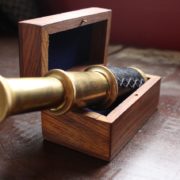The Four Types of Discovery in Escape Rooms, Part I: Finding the Hidden
 Central to the experience of an escape room is the act of discovery. At the very least, every escape room involves the discovery of what lies inside. Think back to your first, second, or hundredth escape room and the one thing they likely all have in common is the time spent in quiet anticipation, waiting to discover what lies beyond the door.
Central to the experience of an escape room is the act of discovery. At the very least, every escape room involves the discovery of what lies inside. Think back to your first, second, or hundredth escape room and the one thing they likely all have in common is the time spent in quiet anticipation, waiting to discover what lies beyond the door.
Discovery in escape rooms can be categorized into four major types: finding what’s hidden, uncovering what’s obscured, realizing a solution, and unraveling the mystery. In this series, we’ll explore each of these discovery types in turn and discuss how we at Locurio use them when designing our experiences.
Designing an escape room that utilizes each of these types of discovery can be challenging, but by understanding them and the effects they have on our players we can build experiences that are more exciting, more memorable, and that much better. So, let’s talk about them!
Finding the Hidden – “Where Is The Puzzle?”
This form of discovery is the classic “toss the room” opening used in many escape rooms. Players search high and low, over and under, inside and out in order to find all of the puzzles, pieces, and data needed to escape. Sometimes these items are hidden in simple places, such as in a desk drawer or even in plain sight. Other times they are fiendishly concealed, perhaps in a secret cache under a floorboard, under a rug, under a 10-ton safe.
 When designing our first escape room, The Vanishing Act, we initially chose to forego this type of discovery. We were concerned that hiding objects felt a bit arbitrary from a story perspective (would someone really keep the combination to their safe tucked away inside the couch?) and, if not done with great care, could be frustrating for players or even feel unfair. We also thought that if there was no incentive for tearing the room apart then we would limit the risk of overly enthusiastic players damaging the room in their fervor.
When designing our first escape room, The Vanishing Act, we initially chose to forego this type of discovery. We were concerned that hiding objects felt a bit arbitrary from a story perspective (would someone really keep the combination to their safe tucked away inside the couch?) and, if not done with great care, could be frustrating for players or even feel unfair. We also thought that if there was no incentive for tearing the room apart then we would limit the risk of overly enthusiastic players damaging the room in their fervor.
In the end, after a lengthy discussion, we decided to include this element in our room. We spent a lot of time thinking about the different ways in which players might enjoy our room. Some would be there to solve challenging puzzles, others would come to be immersed in a compelling story and, we realized, some would come because they really enjoy the hunt for clues. After all, it’s not every day that you get to tear apart a room, scouring it for hidden puzzles!
The trick was to do it in a way that mitigated our concerns while still allowing for the satisfying experience of discovering hidden clues. While players must still search our room, we chose not to put anything under furniture, up high, or inside anything that needed to be dismantled. Players still need to be thorough enough to find everything and clever enough to realize what is and is not a puzzle, but they will never feel (hopefully) that we have unreasonable expectations on the lengths they must go to find the puzzles.
This series is continued in Part 2: Uncovering the Obscured.
And so ends the first Locurio blog post. Join us here each week as we discuss escape rooms, puzzles, and various other topics related to the design of immersive experiences. Who knows, you might just discover something new!
Disagree with what we’ve said? Think we forgot something? Just want to lavishly praise us and tell us how good-looking we are? Let us know what you think in the comments below.
For the sake of readers who have yet to enjoy The Vanishing Act or any of our other experiences, we ask that you kindly refrain from spoilers in your comments.



The concept is beautiful and it was a pleasure to participate. Keep it up guys!
I’ve been hearing a lot about escape rooms, and I think that it would be something fun to try out. I’m glad that you talked about being able to design an escape room, and some of the things that went into it. I’m going to have to look for a good escape room I could try with some friends and see how I like it! Thanks!
It’s very fun to put together all the missing peaces…even more fun if all the people participate and nobody is left aside 🙂 because it’s a common problem I think 🙂 Thanks for the article Philip 🙂
I’ve never been to an escape room before. Some friends have been thinking about going so I might go check it out. I’d be all for it since I do like figuring out puzzles.
I think your idea of limiting the risk of players damaging the escape room in their ‘quest’ by providing them with no incentive for tearing the room apart in the first place. My friends and I especially love escape rooms and puzzle rooms. We used to go hunt for escape rooms to play once every 2 weeks before the Covid 19 pandemic. I would imagine that once the restrictions are lifted, the gang will look forward to our new ‘quest’ soon.